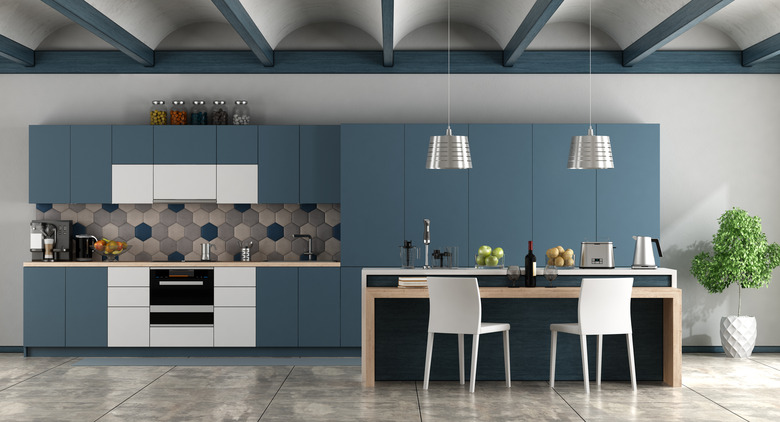How Thick Is Ceramic Tile?
We may receive a commission on purchases made from links.
Knowing the thickness of ceramic tile is important if you plan to use it in your next renovation or the design of a new home you're building. Although it plays a strong aesthetic role in your design, tile isn't simply a visual medium, like paint or wallpaper. It's a physical building material, and if you don't allow for its thickness, you may find yourself hastily adjusting everything from your doors to the transitions between different flooring materials.
Tip
Ceramic tile varies in thickness, but most will fall between 1/8 inch and 1/2 inch depending on size and intended purpose.
Thickness of Ceramic Floor Tiles
Thickness of Ceramic Floor Tiles
Square tiles are the most common choice for flooring, though rectangular tiles are also popular, and specialty shapes and styles (octagonal, hexagonal, trapezoids, penny tile) provide options when you're looking for high visual impact. Sizes vary substantially. Standard sizes for square tiles begin at 2 x 2 inches and go up to 24 x 24 inches, and other shapes are sized similarly.
Typical thicknesses range from 3/8 inch to 1/2 inch for floor tiles, with most in the 1/3- to 1/2-inch range and larger tiles generally being thicker than smaller ones. Some tiles will fall outside this range, with oversized tiles sometimes reaching 5/8 inch in thickness and smaller ornamental tiles being as little as 1/8 inch thick. If you're purchasing from a European supplier, metric thicknesses for floor tiles typically begin at 10 millimeters (approximately 3/8 inch) and increase from there.
Thickness of Ceramic Wall Tiles
Thickness of Ceramic Wall Tiles
Ceramic wall tiles are thinner for several reasons. Floor tiles need to be thick to withstand years of foot traffic, the weight of furniture, and the sharp shock of dropped objects. None of those apply to wall tiles, and the reduced weight of a thinner tile makes for easier installation. Thicknesses of 1/4 inch to 3/8 inch are typical (6 to 10 mm in metric sizes), though again, decorative tiles may be as thin as 1/8 inch.
As with floor tiles, sizes and shapes will vary. Square and rectangular shapes are the most common, but for design purposes, you might turn to specialized shapes or oversized tiles in order to gain visual impact. Floor tiles can be used on walls if you're prepared to work around their added thickness and weight. Wall tiles shouldn't be used on floors, as they're not designed to stand up under that kind of usage.
Allowing for Thinset and Underlayment
Allowing for Thinset and Underlayment
The thickness of the tile itself isn't your only consideration. Ceramic tiles aren't "peel and stick," as some vinyl tiles are. They're held in place by a specialized type of mortar called thinset, and very often, a backerboard, membrane, or other underlayment as well.
The thickness of your thinset layer is determined by the notch size of the trowel you use. For floor installations, that's typically a trowel with a 3/8-inch notch, which, when the tiles are installed, means the thinset flattens out to 3/16 of an inch. For larger tiles, you might use a trowel with a 1/2-inch notch, which flattens out to 1/4 inch of thinset. Ask your tile supplier what's appropriate for the specific tile you've chosen or check the manufacturer's website.
So, adding 3/16 inch of thinset to (for example) a 1/2-inch tile gives a tile thickness with thinset of 11/16. That's still not the final story because some installations may require a self-leveling compound, backerboard, or uncoupling membrane in order to even out the subfloor or provide a more durable, long-lasting floor installation. Finally, you may need to allow for irregularities in the thickness of decorative or handmade tiles, and especially if you're installing your own tile, you will almost certainly need to allow for some unevenness in the thinset.
Why Thickness Matters
Why Thickness Matters
As with any other DIY or home renovation project, proper preparation can help you avoid costly mistakes and do-overs once your project is underway. Reading information on a few guide or tip websites is a good starting point.
Once you've moved on to detailed planning, getting the thickness of your tiles correct is one of those key details. On a wall, for example, you'll need to position electrical boxes at a depth that leaves their wall plates flush with the finished tile — i.e., your wall tile thickness allowance — rather than the underlying drywall. With floor tiles, you'll need to be sure your doors will swing freely over the installed tile and allow for the height of your tiles when installing cabinetry and countertops.
It's especially important when you mix different types of flooring. Suppose, for example, your kitchen will have ceramic tile, but the adjoining dining and living areas use luxury vinyl tile (LVT). If the LVT checks in at 4 millimeters of thickness with a 1 mm underlay, that's 5 mm in total, or about half the thickness of a 3/8-inch tile without the thinset. To avoid an awkward transition, you'll need to use a thicker underlay beneath the LVT. Similarly, if you plan to incorporate a border of thinner decorative tiles alongside your thicker main tiles, you'll need to add a cut-to-size strip of backerboard (maybe two) under the thinner tiles in order to maintain a consistent floor height.
